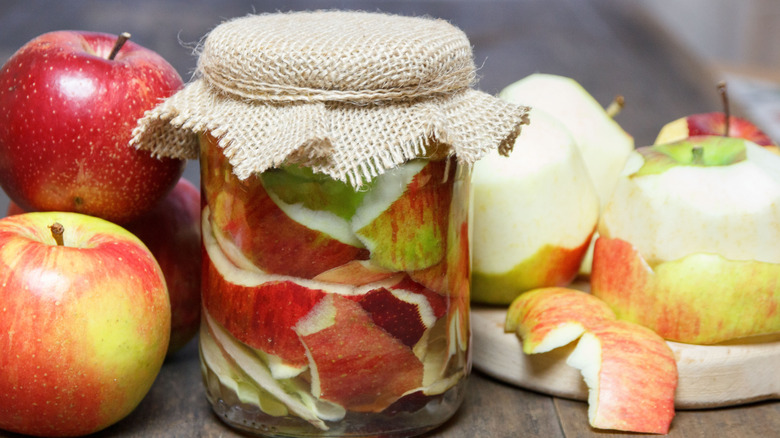The Typically Discarded Food Item That Gives Salads A Sweet Pop
To peel or not to peel? While some apple recipes, such as our quick and easy Swedish apple pie, don't require any peeling, others, such as homemade apple butter, do require this step and will leave you with unwanted apple scraps. But reconsider before you toss out the peels. Not only can apple peels add fiber to a smoothie, but they can also make for a sweet (and still fibrous) salad garnish.
There are actually two ways to enhance your salad with apple peels. The easiest is to slice them into thin strips and scatter them over the top, where they'll look pretty and lend fruity flavor. A slightly more complicated method involves tossing them with oil or melted butter and then baking them to turn them into crispy apple chips. Left plain or sprinkled with salt, these chips make the perfect topping for a fall-themed salad with dried cranberries and a maple vinaigrette dressing. You could also sprinkle the apple peel chips with cinnamon sugar and eat them as a standalone snack.
Apple peels can also provide a sour kick
If you aspire to a zero-waste kitchen and don't mind putting in a little effort, there's one more way you can enhance your salads with the aid of both apple peels and cores: Use them to make homemade cider vinegar. While this may sound like a pretty high-level undertaking, Homemade vinegar is actually pretty doable, although the process can be time-consuming. For starters, you'll need to save up your apple scraps, since it takes about a dozen apples' worth to make a quart of vinegar. If you're not peeling this many apples at a time, just save the peels and cores in your freezer.
When you have enough scraps, pack them into a jar, squishing them down as much as possible. Fill the jar with water, sweetening it with a few spoonfuls of sugar. Cover the jar with cheesecloth or a coffee filter, then let it sit in a warm, dark place for a few days until it gets bubbly. Once it does, stir the mixture every day until the bubbling subsides. At this point, it'll need to be strained, but it's not quite vinegar yet. Back into the closet it goes for another few weeks until it has that sharp, tangy taste you want in a vinegar. (A few weeks' time can turn wine into vinegar, too.) Note: This homemade vinegar isn't pasteurized, so it's best to store it in the refrigerator, where it can last for up to a year.

